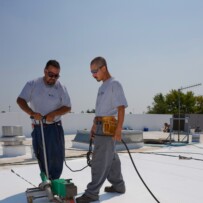
Summer is upon us! This is great news for those of us living in colder regions of the country. But wherever you live one thing is true—summer means hotter days.
Professional roofing contractors are familiar with dealing with the heat, but it’s easy to lose track of rest, hydration and other keys to preventing heat-related injuries while meeting demanding construction schedules. But effectively dealing with the summer heat can prevent work-related injuries, days off work due to illness, loss in productivity, and even death.
The Occupational Safety & Health Administration (OSHA) reported that in 2012, a temporary roofing contractor, on his first day of work, developed a heat stroke and later died in Miamisburg, Ohio. So it is important to stay on guard against heat-related illnesses. OSHA also states that “…under the OSH [Occupational Safety and Health] Act, employers have a duty to protect workers from recognized serious hazards in the workplace, including heat-related hazards.”
GenFlex recommends doing your own research on the topic and developing your own program to deal with heat that fits your situation. Most of the information found in this article is derived from the National Institute for Occupational Safety and Health (NIOSH).
Heat-related Illnesses
We will focus on two of the most serious heat-related illnesses—heat exhaustion and heat stroke.
Heat Exhaustion
Heat exhaustion is a response to dehydration and loss of salt. Symptoms include headaches, nausea, dizziness, weakness, irritability, thirst, heavy sweating, elevated body temperature, and decreased urine output. If a worker is experiencing the above symptoms, NIOSH suggests you perform the following First-Aid actions:
- Take the worker to a clinic or emergency room for medical evaluation and treatment.
- If on-site or nearby medical care is unavailable, call 911.
- Remove the worker from the hot area and give frequent sips of cool water.
- Remove unnecessary clothing, including shoes and socks.
- Cool the worker with cold compresses.
Heat Stroke
Heat stroke happens quickly when the body is no longer able to control its temperature. Symptoms include confusion, altered mental status, slurred speech, loss of consciousness (coma), hot dry skin or profuse sweating, seizures, and a very-high body temperature. NIOSH suggests you perform the following First-Aid actions:
- Call 911 for emergency medical care.
- Move the worker to a shaded, cool area, and remove outer clothing.
- Cool the worker quickly with cold water or an ice bath if possible.
- Circulate the air around the worker to speed cooling.
Prevention
Make sure every worker is aware of the symptoms of heat exhaustion and heat stroke. They should also know what first-aid steps are required. Emphasize the need for hydration. Teach them to look out for one another, and to immediately report any symptoms or signs of heat-related illness.
OSHA also recommends using the heat index system, which combines both air temperature and relative humidity to represent how hot it will actually feel. Download OHSA’s free app to help you calculate the heat index here: //www.osha.gov/SLTC/heatillness/heat_index/heat_app.html
We hope that this article increases your awareness on heat-related illnesses. Remember to do your own research or rely on professionals you trust to develop a program to deal with the heat.
Additional Resources
NIOSH: //www.cdc.gov/niosh/topics/heatstress/default.htm
OSHA: //www.osha.gov/SLTC/heatillness/index.html
CDC (Free poster PDF and other media): //www.cdc.gov/extremeheat/materials.html
For more Safety Tips and stories, be sure to follow GenFlex on Facebook, LinkedIn and Twitter.
